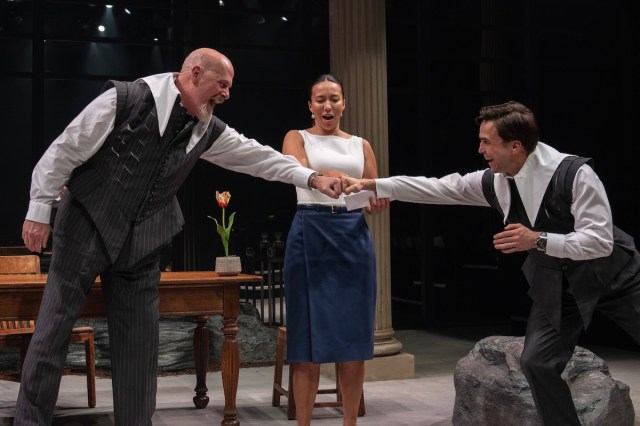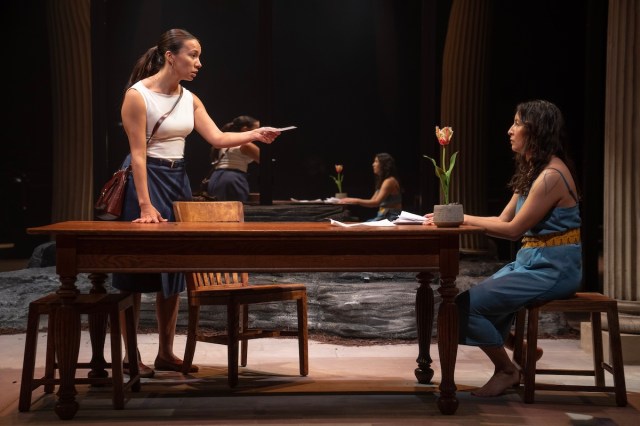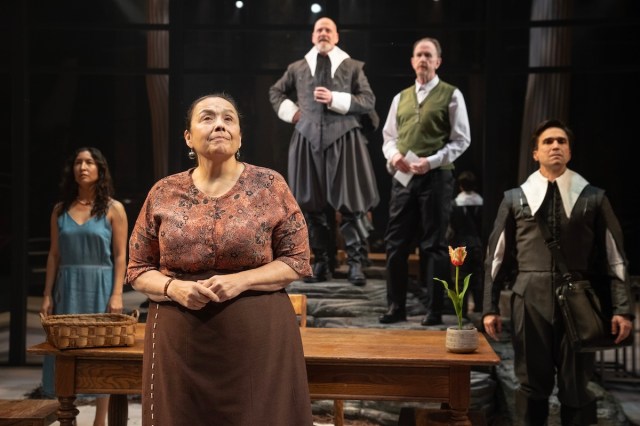Review: Mary Kathryn Nagle’s Manahatta Is a Land Acknowledgment Writ Large
The Native American playwright’s thought-provoking and ambitious play makes its New York premiere at the Public Theater.

(© Joan Marcus)
When live theater started returning in 2021, many venues in Manhattan began making “land acknowledgments,” pre-show announcements recognizing that their locations were originally inhabited by the Lenape people. However well-meaning, such a gesture has felt increasingly insufficient the longer the practice has persisted — acknowledgments are one thing, action another.
In that respect, Mary Kathryn Nagle’s Manahatta offers a useful service: She is a Native American playwright reminding us what it truly means to reckon with the blood that white Americans have shed in the name of independence and progress. Thankfully, Nagle’s ambitious play, making its New York premiere at the Public Theater, has more to offer than just a history lesson.
Nagle’s ambition is as much structural as dramatic and historical. Manahatta weaves two distinct time periods together, with each member of its seven-performer ensemble playing one character in each period. Half of the play is set in the early 21st century and revolves around both Jane Snake (Elizabeth Frances), a financial mathematics major who lands a job at a major investment bank; and her Lenape family back in Oklahoma, including her mother Bobbie (Sheila Tousey) and sister Debra (Rainbow Dickerson), struggling to make ends meet after the death of their father. The other half, set in the 17th century, is a fictionalized dramatization of the Lenape’s land sale of Manahatta to Peter Minuit (Jeffrey King), in which Minuit tricked the Lenape into giving the land away at a ridiculous discount and then violently oppressed them when they began to rebel against his iron-fisted rule.

(© Joan Marcus)
As the details of Jane’s present-day ascent in the investment accumulate, Nagle’s reason for juxtaposing these two threads gradually becomes clear. Turns out, the investment bank at which Jane toils mightily is Lehman Brothers, one of the architects of the financial crisis that eventually brought the company down in 2008 (the aforementioned King doubles as its CEO, Richard Fuld). And while Jane begins to make a name for herself at Lehman, her mother becomes a victim of the predatory lending practices that led to the crisis. Manahatta suggests a parallel between the way investment bankers fooled desperate wannabe homeowners into taking on worthless debt packages and the way Dutch colonists fooled the Lenape into giving up their land at a rock-bottom price.
Daring as that grand comparison is, Manahatta does betray hints of the overly schematic in the way it goes about making that point. Good thing Nagle is as much concerned about micro personal and cultural matters as about macro historical ones. As the only Native American at Lehman, Jane feels a particular pressure to succeed, pitching her success as shining a way forward for other like her in previously white-dominated industries. Ironic, then, that Jane herself barely seems to have much of a connection to her Lenape heritage. She doesn’t even know the Lenape language, which Debra and their mother had promised their father that they would pass on to future generations through a language school, a plan that their housing woes jeopardize. That sense of sorrow at the prospect of a whole culture being ground underfoot underlies the whole play.

(© Joan Marcus)
Director Laurie Woolery negotiates the switches between time periods with welcome clarity and fluidity, relying on Jeanette Oi-Suk Yew’s lighting design and Lux Haac’s costume design to indicate changes in time and place even as Marcelo Martínez García’s scenic design remains more or less the same throughout. The only questionable aspect of Woolery’s staging lies in her decision to occasionally have actors leave contemporary clothes on while switching to 17th-century scenes, and vice versa. However clumsy it might seem in the moment, though, that choice is true to Nagle’s instruction in her script to “make clear to the audience that past and present overlap and co-exist.”
No such doubts exist with the excellent cast. Frances’s driving ambition as Jane plays off nicely against Dickerson’s mellower manner as her sister. As Michael, a friend of the Snake family who offers Bobbie the loan that will eventually do the family in, David Kelly radiates genuine warmth and concern, as does Enrico Nassi as his son Luke. Both provide a stark contrast to both King’s macho bluster as the aforementioned Dick Fuld and Joe Tapper’s similarly blunt manner as one of Jane’s colleagues, Joe. Sheila Tousey, however, offers the standout performance of the ensemble, bringing to Bobbie a dry wit that eventually curdles into a poignant sense of regret. A monologue she delivers toward the end of the play, in which she reminisces about how she met her husband and painfully revisits her decision not to teach her two daughters Lenape, offers a quietly moving capper to this intriguing, thought-provoking, and overall worthwhile play.









